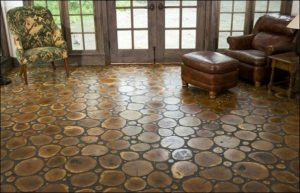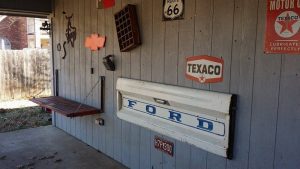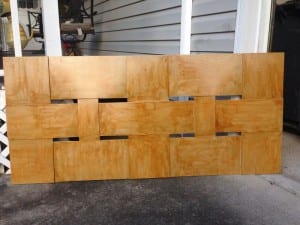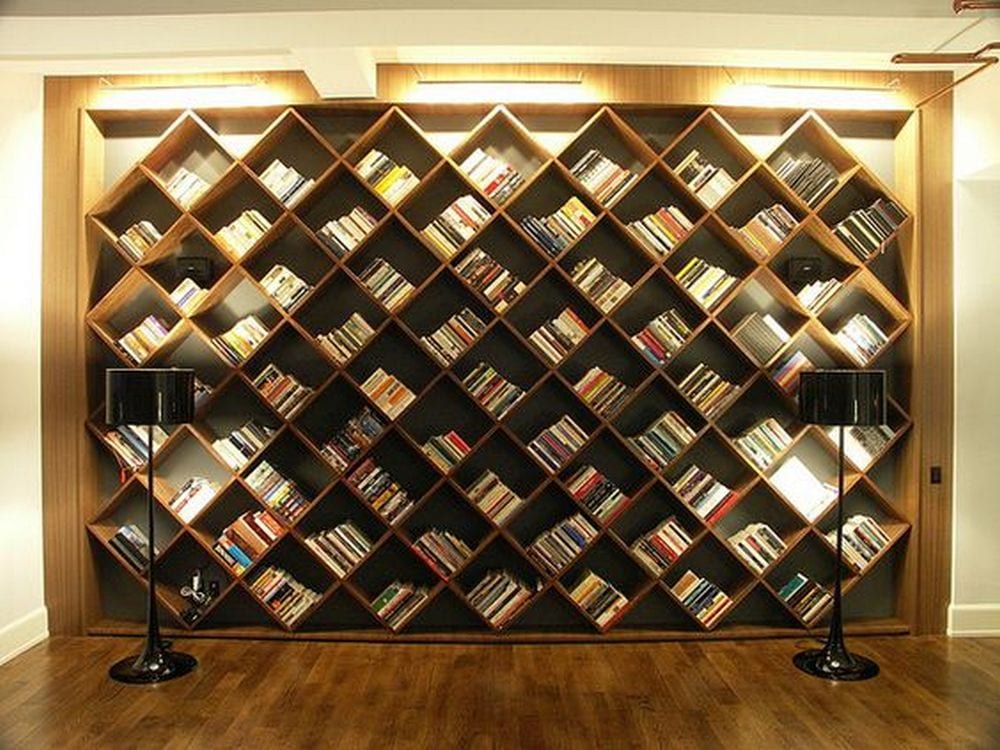
Making your own furniture is immensely satisfying. There’s something special about being able to see the product of your own hard work and effort. This particular DIY project is guaranteed to bring a smile to your face: a diagonal bookshelf. This bookshelf is unique because it’s not the typical rectangular shape. It’s diagonal, which makes it stand out and adds a bit of extra interest.
We love seeing the creative, charming, and interesting ways that readers integrate bookshelves into their homes. It’s always so fascinating to see how people use bookshelves to reflect their personal style and taste. Whether it’s a cozy nook filled with your favourite reads or a grandiose library with floor-to-ceiling shelves, bookshelves can really make a space feel like your own. We love seeing how our readers make bookshelves such an integral and personal part of their homes.

When it comes to displaying books, the sky is the limit in terms of creativity. Why settle for a boring old bookshelf when you can have something out of the ordinary? There are so many fun and unique ways to showcase your books, and doing so can make reading all the more enjoyable.
This modern DIY bookshelf project is a great way to give an old, boring bookshelf a total upgrade. The sleek, contemporary look is sure to draw the interest of anyone who sees it. Plus, it’s easy to do yourself with just a few simple materials. So why not give it a try?
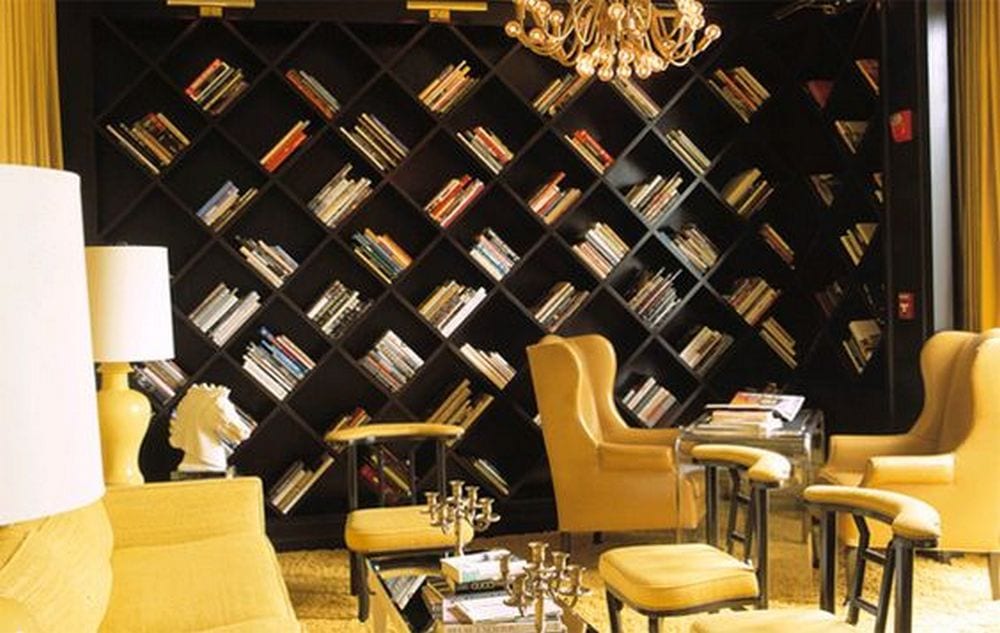
This beautiful, handcrafted diagonal bookshelf is both visually appealing and functional. A furniture piece like this is a must-have for any home. You’re going to have to put your woodworking skills into practice but the finished product is totally worth it. This diagonal bookshelf is the perfect way to display your favourite books, photos, and knick-knacks. It’s also a great conversation starter, so be prepared to get compliments from your guests!
Contents
Diagonal Bookshelf DIY Guide
Materials
- Wooden boards
- L brackets
- Wood screws
- Black paint
- Dry wood spackle
Tools
- Sandpaper
- Small rolling paintbrush
- Foam paintbrush
- Table saw
- Chop saw
- Measuring tape
- Oscillating saw
Instruction
Step 1: Design and Planning
- Sketch the Design: Draw a detailed plan of your bookshelf, including dimensions and the angle of the diagonal shelves.
- Measure Space: Use the measuring tape to determine the space where the bookshelf will go, ensuring your design fits the area.
Step 2: Cutting the Wood
- Mark the Wood: Based on your design, mark the cutting lines on your wooden boards with a pencil.
- Cut the Wood: Use the table saw for straight cuts and the chop saw for angled cuts. For intricate cuts or adjustments, use the oscillating saw.
Step 3: Sanding
- Sand Surfaces: Smooth all edges and surfaces of the cut wood with sandpaper to prepare for painting.
Step 4: Assembling the Bookshelf
- Lay Out Pieces: Arrange the wooden boards on the floor or a large table according to your design.
- Attach L Brackets: Secure the shelves to the sides using L brackets and wood screws. Ensure each shelf is level before tightening the screws.
Step 5: Applying Spackle
- Fill Gaps: Use dry wood spackle to fill any gaps or holes. Allow it to dry according to the product instructions.
- Sand Again: Lightly sand the spackled areas for a smooth finish.
Step 6: Painting
- Apply Primer (Optional): For a more professional finish, apply a primer before painting. Let it dry completely.
- Paint the Bookshelf: Use the foam paintbrush for hard-to-reach areas and the small rolling paintbrush for larger surfaces. Apply black paint evenly. Consider multiple thin coats for the best finish, allowing adequate drying time between coats.
Step 7: Final Touches
- Inspect and Touch-Up: Check for and touch up any missed spots or uneven areas with the foam paintbrush.
- Install and Secure: Place the bookshelf in its designated spot. Use the measuring tape and level to ensure it’s positioned correctly and securely anchor it to the wall to prevent tipping.
Step 8: Decorating Your Bookshelf
- Arrange Your Items: Once the paint has dried and the bookshelf is securely installed, you can start arranging your books, photos, and knick-knacks.
Designing Your Diagonal Bookshelf
Creating a diagonal bookshelf that complements your space and meets your storage needs requires careful planning and design. This unique piece of furniture serves as a functional storage solution and a statement piece in your home. Here’s how to get started on designing your very own diagonal bookshelf.
Sketch Your Design
Begin by sketching your bookshelf on paper. Think about the overall shape and how many shelves you want. Your sketch should include the diagonal lines that make this bookshelf stand out. Consider the height and width of the bookshelf and how it will fit in your intended space. This initial drawing will serve as the blueprint for your project.
Plan Dimensions and Space
Next, measure the space where you plan to place your bookshelf. Based on these measurements, determine the dimensions of your bookshelf. Remember to consider the size of items you plan to store on the shelves. For larger items, you may need to adjust the spacing between shelves. Planning for space is crucial to ensure that the bookshelf is both practical and aesthetically pleasing.
Customize Your Design
Your diagonal bookshelf doesn’t have to follow a one-size-fits-all approach. Customize your design to match your personal style and the decor of your room. Think about adding unique features, such as varying shelf lengths or incorporating different materials or colors. Customization allows you to create a piece that is truly your own and reflects your personal taste.
Click on any image to start the lightbox display. Use your Esc key to close the lightbox.
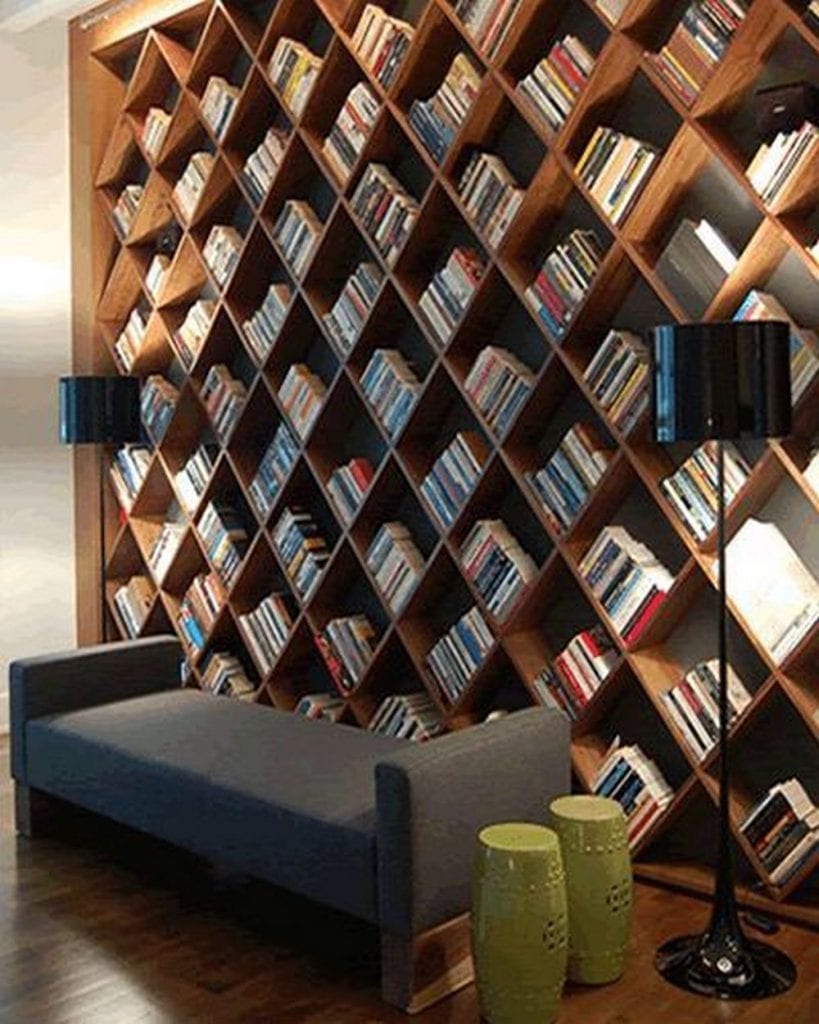

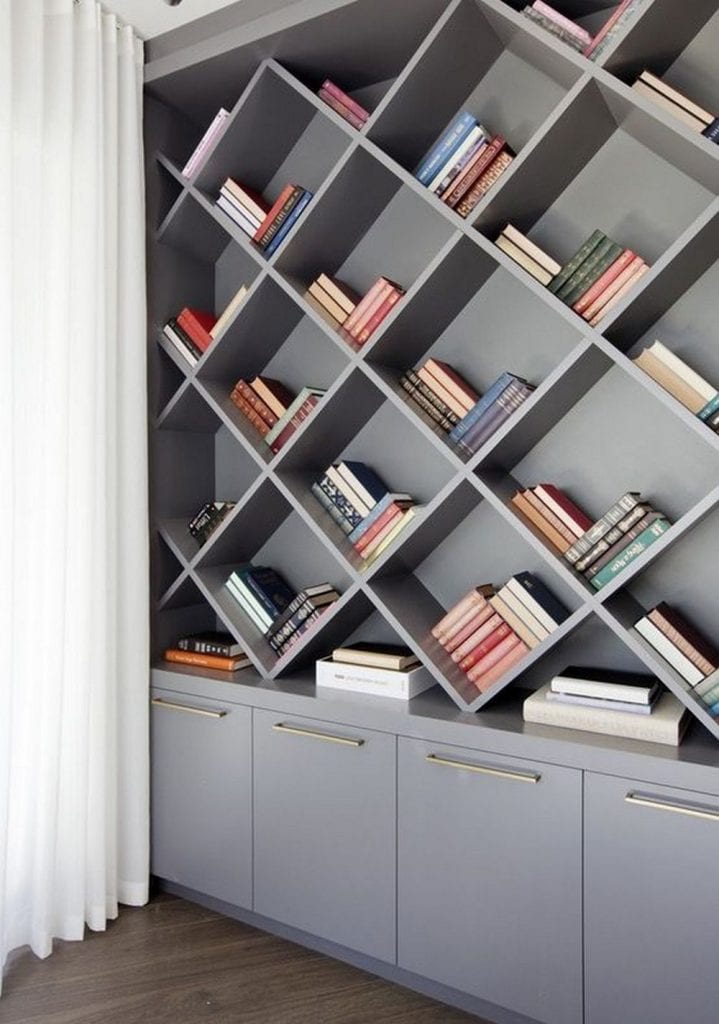
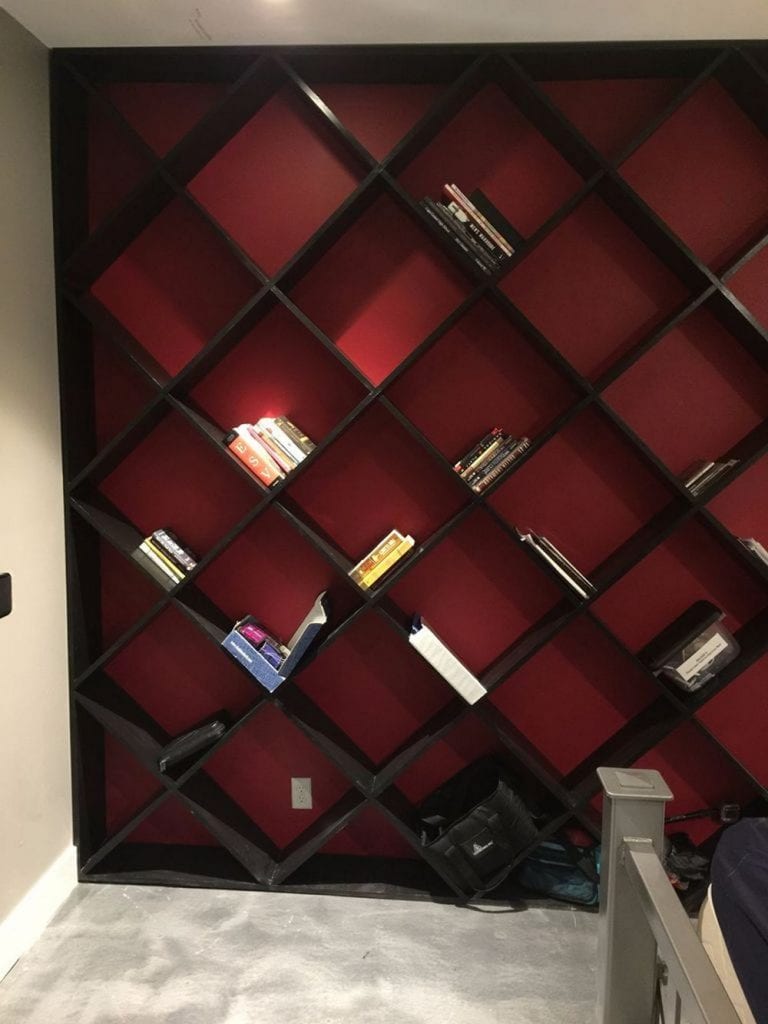
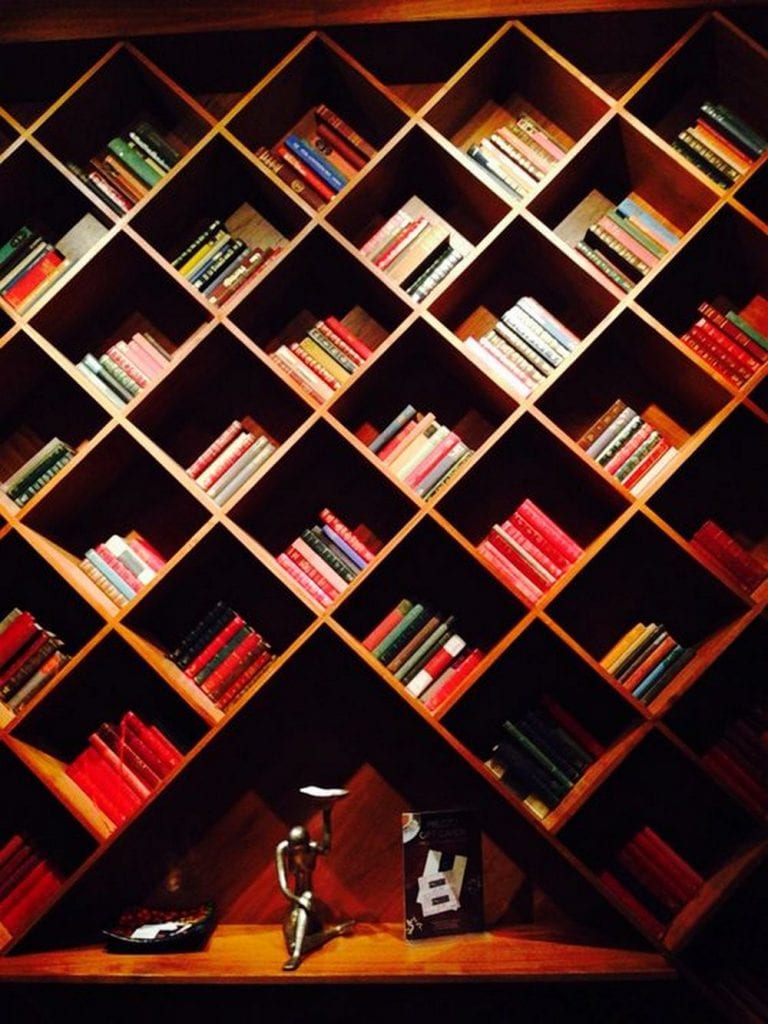
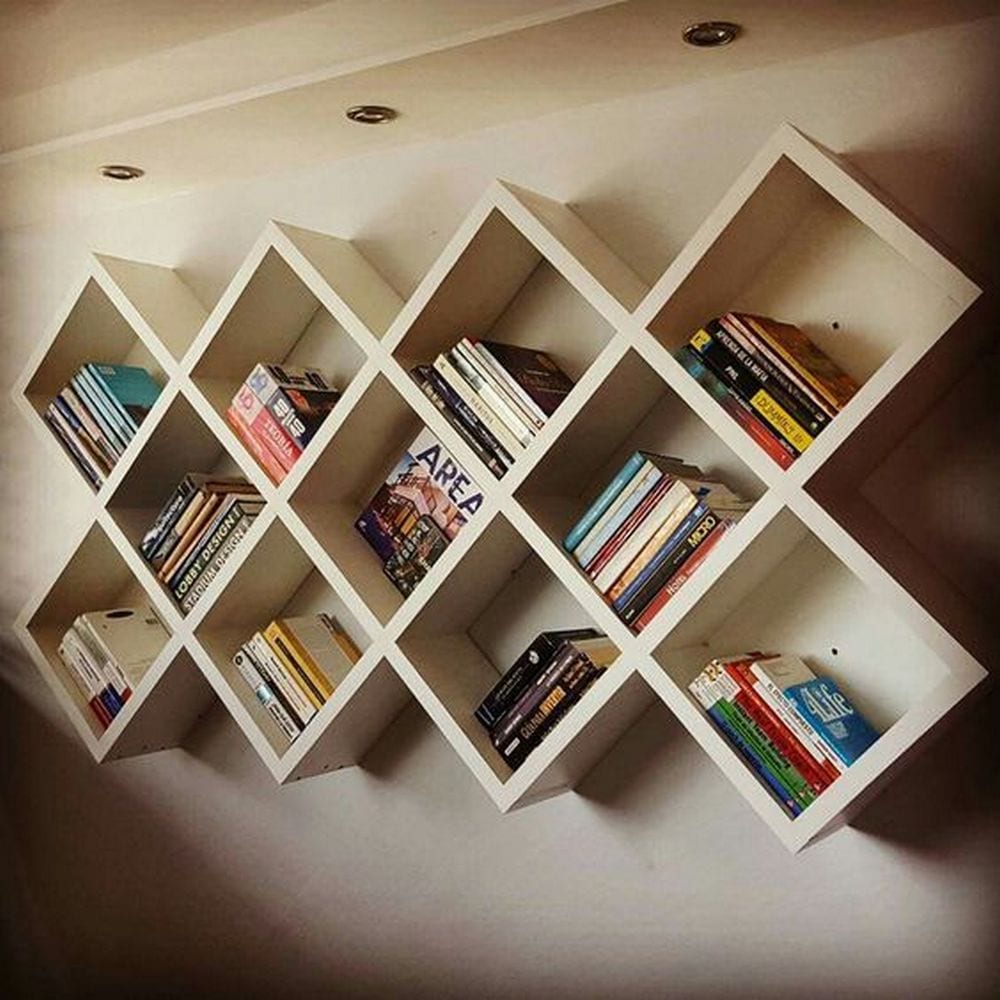

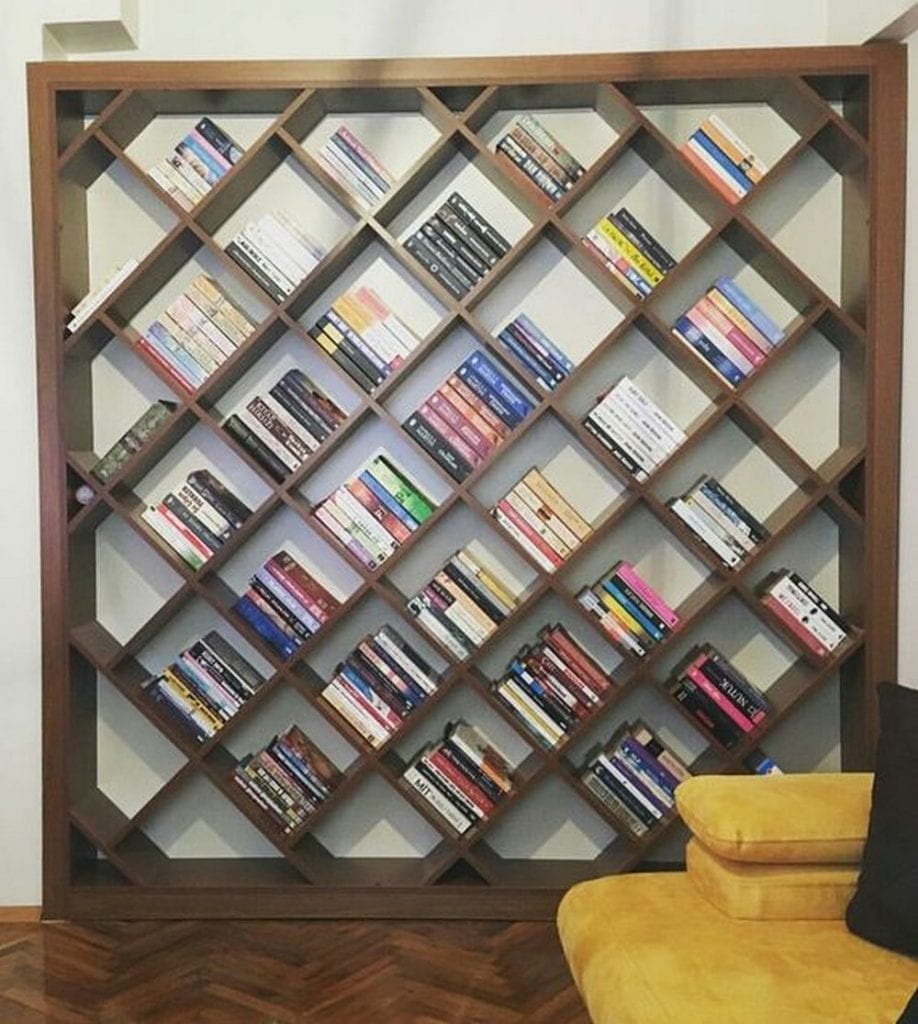

Learn how to build your own diagonal bookshelf. Get the step-by-step instructions here...
DIY Tips and Tricks for Building a Diagonal Bookshelf
Building a diagonal bookshelf can be a rewarding DIY project. You can create a stunning piece with the right approach that adds character and function to any room. Here are some essential tips and tricks to help you through the process, ensuring a smooth and successful build.
Choose the Right Tools
Selecting appropriate tools is fundamental for the success of your DIY diagonal bookshelf project. A reliable table saw is essential for making straight cuts, while a chop saw will be invaluable for precise crosscuts and miter cuts, ensuring that all pieces of your bookshelf align correctly.
An oscillating saw is particularly useful for making intricate cuts or adjustments that other saws might not manage as easily. In addition to saws, high-quality sandpaper is necessary for smoothing rough edges and surfaces, contributing to both the aesthetic and safety of your bookshelf. Paintbrushes of good quality are crucial for applying paint or finish evenly, avoiding streaks or drips that could mar the appearance of your project.
Don’t forget the importance of accurate measuring tools, such as a tape measure and a level; these are indispensable for ensuring that your shelves are perfectly aligned and your bookshelf is well-proportioned.
Investing in or borrowing high-quality tools can significantly impact the ease of construction and the quality of your finished bookshelf. Remember, using the right tools facilitates a smoother building process and contributes to a more professional-looking end product.
Measure Twice, Cut Once
When building a diagonal bookshelf, precision in measurement cannot be overstated. Diagonal cuts, in particular, require a higher degree of accuracy than straight cuts, as even minor discrepancies can lead to gaps and misalignments in the assembly.
Before proceeding with any cuts, take the time to verify your measurements at least twice. This practice helps prevent wastage of materials and ensures that each piece of your bookshelf fits together seamlessly. It’s helpful to use a carpenter’s square or a precision measuring tool to ensure that all angles and lengths are correct.
The extra step in the measuring process can save you considerable time and effort in the long run by reducing the need for adjustments and re-cuts. Accurate measurements are the foundation of a well-built bookshelf, ensuring the structure is stable, visually appealing, and functions as intended. Remember, patience and meticulousness during the measuring phase can greatly enhance the quality and fit of your finished diagonal bookshelf.
Ensure Stability and Safety
Ensuring the stability and safety of your diagonal bookshelf is crucial, especially when it’s intended to hold a significant amount of weight. Incorporating L brackets into your design provides the dual benefit of reinforcing the shelf structure and securing the shelves firmly in place. These brackets, when combined with robust wood screws, offer additional support that can bear the weight of heavy books or decorative items without sagging or shifting.
For households with children or pets, anchoring the bookshelf to the wall is a necessary safety measure. Wall anchors can prevent the bookshelf from tipping over, protecting your loved ones and possessions.
This step is particularly important for taller or freestanding bookshelves with a greater risk of falling. Including these safety features in your design will ensure the longevity of your bookshelf and provide peace of mind, knowing that your home is safer.
Sanding and Finishing
Sanding and finishing your bookshelf plays a pivotal role in its appearance and safety. Sanding down the wood to a smooth finish is essential for removing any splinters or rough edges that could cause injury.
Begin with a coarser grit sandpaper to remove any major imperfections, and gradually move to finer grits for a smooth finish. This meticulous preparation enhances the wood’s texture and prepares it for painting or staining.
Using a foam brush can be particularly effective for achieving a smooth, uniform coat when applying paint or stain. Foam brushes minimize brush strokes and can easily reach into the crevices of the diagonal design.
Applying multiple thin coats rather than a single thick coat ensures even coverage and allows the paint or varnish to dry properly, resulting in a more durable and attractive finish. This careful attention to sanding and finishing improves the aesthetic appeal of your bookshelf and contributes to its overall safety and longevity.
Be Creative with Paint and Finish
The finish you choose for your diagonal bookshelf plays a significant role in defining its character and how it complements your interior space. Engaging with a palette of paint colors or varieties of wood stains opens up a world of possibilities.
Opt for bold and vibrant colors to make your bookshelf a standout feature, or select hues that harmonize with your existing room decor to create a seamless look. Experimenting with different finishes, such as matte, gloss, or satin, can alter the room’s vibe.
For those looking to add an extra layer of texture or a unique touch, techniques like distressing or applying a faux finish can impart an antique or thematic flair, respectively. The right finish can transform your diagonal bookshelf from merely a place to store books into a striking focal point that draws the eye and sparks conversation.
Plan for Adjustments
No matter how thorough your preparation is, creating a diagonal bookshelf may require you to make some adjustments along the way. The nature of custom DIY projects is such that flexibility becomes a key component of success.
You might find the need to trim a shelf slightly to fit better or re-drill a hole to ensure that screws fit perfectly. These modifications are normal and should be seen as steps toward refining your bookshelf. Adjusting as you go allows you to adapt to unforeseen challenges and perfect your craft.
This ability to tweak and improve often leads to a more polished and satisfying end product. Embrace these moments of change as opportunities to enhance your diagonal bookshelf, ensuring it meets your initial vision and possibly even surpasses it.
Incorporating a Diagonal Bookshelf into Home Decor
A diagonal bookshelf is not just a storage solution; it’s a statement piece that can enhance the aesthetics of any room. Its unique design adds a dynamic element to home decor, offering both functionality and style. Here’s how to seamlessly integrate a diagonal bookshelf into your home decor, ensuring it complements your living space while standing out as a focal point.
Choose the Right Location
The placement of your diagonal bookshelf can greatly affect its impact on your decor. Consider high-visibility areas like the living room, which can become a centerpiece or a cozy corner in your bedroom for a personal reading nook. Ensure the location allows the bookshelf to stand out without obstructing traffic flow or overwhelming the space.
Coordinate with Room Decor
Matching the diagonal bookshelf with your room’s decor is key to creating a cohesive look. If your room features a modern aesthetic, a diagonal bookshelf painted in bold black or a sleek white can complement the theme. For rooms with a rustic charm, consider a natural wood finish. The color and finish of your bookshelf should enhance your room’s color scheme and style.
Utilize as a Display Piece
A diagonal bookshelf offers unique opportunities for display. Arrange books creatively by color or size to make a visual impact. Incorporate decorative items like vases, picture frames, and planters to add personal touches. This highlights your interests and style and breaks the monotony of rows of books, making the bookshelf a captivating feature in your home decor.
Lighting and Accessories
Proper lighting can elevate the look of your diagonal bookshelf and the items displayed on it. Consider installing LED strip lights beneath each shelf to showcase your books and decor pieces. Adding accessories like small sculptures or artwork on or near the bookshelf can tie the theme together, enhancing the overall decor.
Create a Focal Point
The distinctive design of a diagonal bookshelf naturally draws attention. Position it as a focal point in your room by arranging seating or placing it against a contrasting wall color. This strategic placement can stimulate guest conversation and provide a backdrop for social gatherings.
Incorporating a diagonal bookshelf into your home decor is a creative way to display your collections while adding a functional piece of furniture that elevates your living space. With thoughtful placement, coordination with your room’s decor, and adding personal touches, your diagonal bookshelf can transform any room into a stylish and inviting space.
FAQ on Building a Diagonal Bookshelf
What is a diagonal bookshelf?
A diagonal bookshelf is a type of shelving that features shelves set at an angle, rather than the traditional horizontal layout. This design creates a dynamic and visually interesting display for books and other items, adding a modern twist to home decor.
How do you build a diagonal bookshelf?
Building a diagonal bookshelf involves designing the shelf, cutting wooden boards to size using a table saw and chop saw, assembling the pieces with L brackets and wood screws, applying paint or finish, and securing the bookshelf to a wall. Detailed step-by-step instructions can guide you through the process.
What materials do I need for a diagonal bookshelf?
You’ll need wooden boards, L brackets, wood screws, paint or stain, and dry wood spackle. For tools, have on hand sandpaper, a small rolling paintbrush, a foam paintbrush, a table saw, a chop saw, a measuring tape, and an oscillating saw.
Can I customize my diagonal bookshelf?
Yes, you can customize your diagonal bookshelf in various ways, including the size, the spacing between shelves, the color, and the finish. You can also decide on the number of shelves and their angles to suit your space and design preferences.
Where should I place my diagonal bookshelf in my home?
A diagonal bookshelf can be placed in any room, including living rooms, bedrooms, and home offices. Choose a location where it can serve as a focal point or complement the existing decor. Consider the bookshelf’s size and the room’s layout to ensure a good fit.
How can I incorporate a diagonal bookshelf into my home decor?
Incorporate a diagonal bookshelf into your home decor by choosing a strategic location, coordinating its color and finish with the room’s scheme, using it as a display piece for books and decorative items, and enhancing it with lighting and accessories to create a focal point.
Conclusion
Constructing a diagonal bookshelf is a fantastic way to add a unique and stylish element to your home decor. By following the steps outlined, from cutting and assembling the wood to applying the final touches of paint and finish, you can create a piece that is functional and a reflection of your personal style. Remember to choose the right tools and materials, measure carefully, and customize your design to fit your space and needs.


